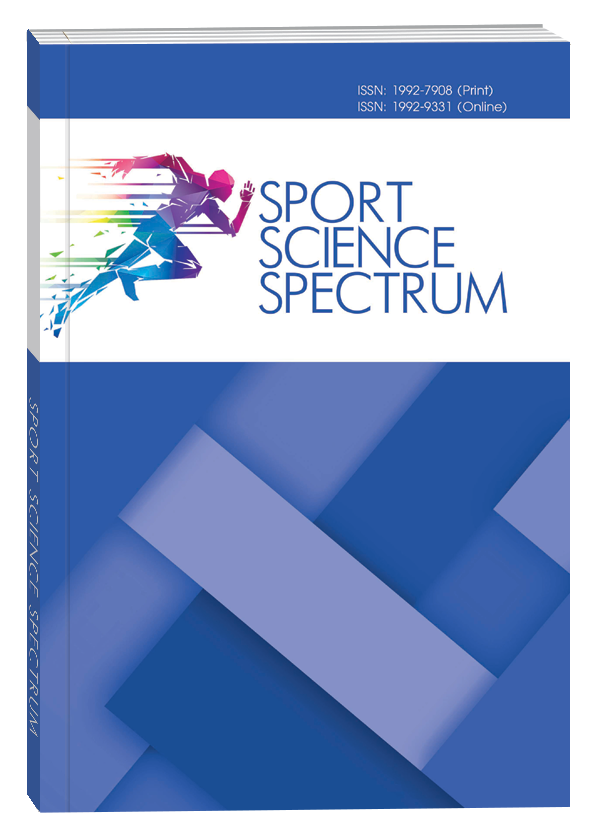TECHNIQUE CHARACTERISTICS OF ATHLETES AGED 13–15 YEARS SPECIALIZED IN RACE WALKING AT THE STAGE OF PRELIMINARY BASIC PREPARATION
DOI:
https://doi.org/10.32782/spectrum/2024-4-2Keywords:
stage of preliminary basic preparation, athletes specializing in race walking, kinematic characteristics of techniqueAbstract
The analysis of the technique of performing a competitive exercise by athletes aged 13–15 years, who specialize in race walking at the stage of preliminary basic training is the basis for further optimization of technical training, both at this and the following stages of long-term improvement.The objective of the study was to determine the main kinematic characteristics of the technique of athletes specialized in race walking at the stage of preliminary basic training. Methods. The kinematic characteristics of the technique of 31 athletes (age – 14,68 years; S = 0,65) at a distance of 3 km at the championships of Ukraine in race walking 2016–2021, as well as the individual dynamics of these indices in two athletes at the stage of specialized basic preparation at a 10 km distance were analyzed. Results. To achieve the level of results at a distance of 3 km – 14:11 (S = 0:22), the average speed at the distance constitutes 3,53 m·s-1 (S = 0,09), stride length – 1,13 m (S = 0,05), stride frequency – 3,13 stride·s-1 (S = 0,12), the duration of the support phase – 0,289 s (S = 0,016), and that of flight – 0,032 s (S = 0,010). The knee joint angle during foot placement on support constituted 179,70º (S = 1,59), the angle of foot placement on support – 69.99º (S = 1,48), and the take-off angle – 60,78º (S = 1–34). Conclusions.The values of technique biomechanical characteristics of athletes aged 13–15 years at the stage of preliminary basic preparation reach high indices and approach those of junior and adult athletes of high national level at distances of 10 and 20 km, respectively. The age of 13–15 years for athletes who specialize in race walking is important for the formation of the basic elements of technique, namely the stride length and frequency and the main kinematic characteristics that affect their values, and should be taken into account when designing their process of technical preparation and long-term improvement strategy in general.
References
1. Бобровник В., Совенко С. Моделювання технічних дій легкоатлетів, які спеціалізуються у спортивній ходьбі, у системі багаторічної підготовки. Sport Science Spectrum. 2024. № 1. С. 4–14. URL: https://doi.org/10.32782/spectrum/2024-1-2.
2. Легка атлетика: теорія і методика тренерської діяльності : підручник / за заг. ред. В. Бобровника, С. Совенка, А. Колота. Київ : Олімп. літ., 2023. Кн. 1. 712 с.
3. Островський М. Відеокомп’ютерний аналіз рухів як засіб контролю за встановленням технічної майстерності атлета. Теорія і методика фізичного виховання і спорту. 2003. № 1. С. 130–133.
4. Платонов В. Система підготовки спортсменів в олімпійському спорті : підручник для тренерів. Київ : Олімпійська література, 2015. Кн. 1. 680 с.
5. Совенко С. Техніко-тактичні особливості подолання дистанції у спортивній ходьбі. Наука в олимпийском спорте. 2020. № 1. С. 81–90. DOI: 10.32652/olympic2020.1_8.
6. Bauersfeld K.-H., Schroter G. Grundlagen der Leichtathletik: Das Standardwerk für Ausbildung und Praxis. Meyer & Meyer Fachverlag, 2015. 712 p.
7. Book of Rules. Official Documents. World Athletics. URL: https://worldathletics.org/about-iaaf/documents/book-of-rules.
8. Caporaso T., Grazioso S. IART: Inertial Assistant Referee and Trainer for Race Walking. Sensors. 2020. Vol. 20. № 3. 30 p. URL: https://doi.org/10.3390/s20030783.
9. Does sex, distance and performance level influence the pacing strategy of race walkers? / D.L. Alves et al. Sport Sciences for Health. 2020. Vol. 17. № 2. P. 335–340. URL: https://doi.org/10.1007/s11332-020-00691-x.
10. Dyer B. The controversy and pragmatic resolution of the introduction of foot sensors in competitive race walking. Technology in Society. 2023. P. 102226. URL: https://doi.org/10.1016/j.techsoc.2023.102226.
11. Gravestock H.J., Tucker C.B., Hanley B. The Role of Upper Body Biomechanics in Elite Racewalkers. Frontiers in Sports and Active Living. 2021. Vol. 3. URL: https://doi.org/10.3389/fspor.2021.702743.
12. Hanley B. A biomechanical analysis of world-class senior and junior race walkers. New Studies in Athletics. 2013. Vol. 28. № 1/2. P. 75–82.
13. Hanley B. Biomechanical analysis of elite race walking : A thesis submitted in partial fulfilment of the requirements of Leeds Metropolitan University for the degree of Doctor of Philosophy. 2014. 303 p.
14. Hanley B., Bissas A., Drake A. Technical characteristics of elite junior men and women race walkers. The Journal of sports medicine and physical fitness. 2014. Vol. 54. № 6. P. 700–707.
15. Hanley B., Tucker C.B., Bissas A. Assessment of IAAF Racewalk Judges’ Ability to Detect Legal and Non-legal Technique. Frontiers in Sports and Active Living. 2019. Vol. 1. URL: https://doi.org/10.3389/fspor.2019.00009.
16. Hoga-Miura K., Hirokawa R., Sugita M. Reconstruction of Walking Motion without Flight Phase by Using Computer Simulation on the World Elite 20 km Race Walkers During Official Races. Slovak Journal of Sport Science. 2017. Vol. 2. № 1. P. 59–75.
17. Pavlović R., Petrović B., Vrcić M. Race Walking: Inversion of Function from the Aspect of Speed and Result Success. European Journal of Physical Education and Sport Science. 2021. Vol. 6. № 11. P. 59–70. URL: https://doi.org/10.46827/ejpe.v6i11.3611.
18. Sovenko S. Technique Characteristics of Skilled Junior Race Walkers. New Studies in Athletics. 2017. Vol. 32. № 3/4. P. 79–84.
19. Sovenko S. Technique characteristics of 13–15-year-old female athletes specializing in race walking at the stage of preliminary basic preparation. Journal of Physical Education and Sport. 2022. Vol. 22. № 1. P. 85–90. URL: https://doi.org/10.7752/jpes.2022.01010.
20. Taborri J., Palermo E., Rossi S. Automatic Detection of Faults in Race Walking: A Comparative Analysis of Machine-Learning Algorithms Fed with Inertial Sensor Data. Sensors. 2019. Vol. 19. № 6. P. 1461. URL: https://doi.org/10.3390/s19061461.
21. Taborri J., Palermo E., Rossi S. WARNING: A Wearable Inertial-Based Sensor Integrated with a Support Vector Machine Algorithm for the Identification of Faults during Race Walking. Sensors. 2023. Vol. 23. № 11. P. 5245. URL: https://doi.org/10.3390/s23115245.
22. The biomechanics of race walking: Literature overview and new insights / G. Pavei et al. European Journal of Sport Science. 2014. Vol. 14. № 7. P. 661–670. URL: https://doi.org/10.1080/17461391.2013.878755.
23. Tucker C.B., Hanley B. Gait variability and symmetry in world-class senior and junior race walkers. Journal of Sports Sciences. 2016. Vol. 35. № 17. P. 1739–1744. URL: https://doi.org/10.1080/02640414.2016.1235793.
24. Using AI Motion Capture Systems to Capture Race Walking Technology at a Race Scene: A Comparative Experiment / D. Zhang et al. Applied Sciences. 2022. Vol. 13. № 1. P. 113. URL: https://doi.org/10.3390/app13010113.





